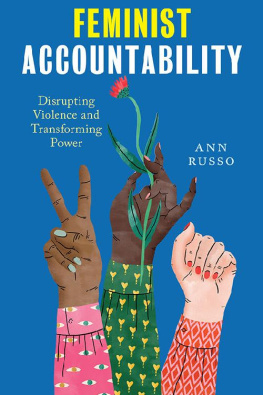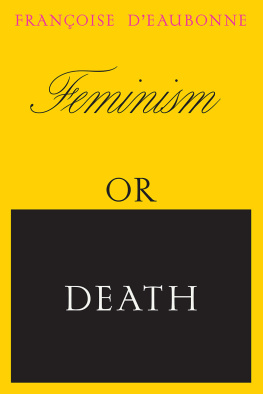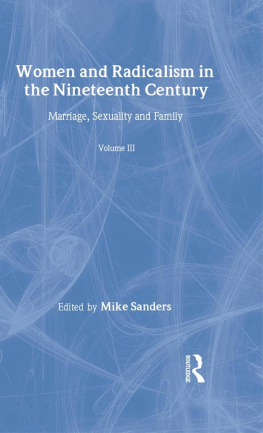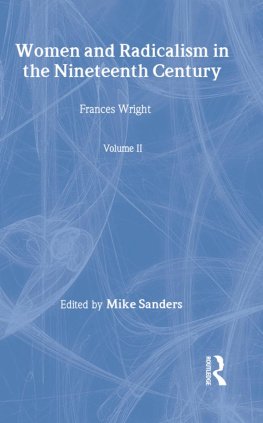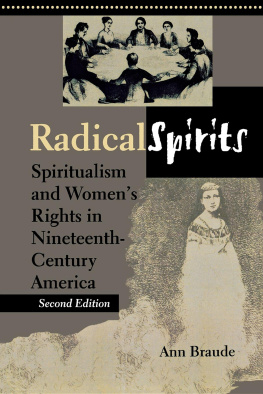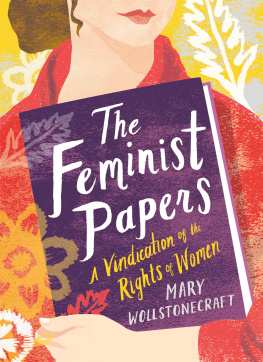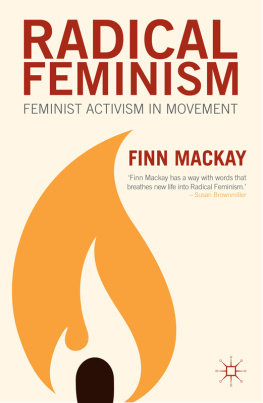WOMENS SOURCE LIBRARY
WOMENS SOURCE LIBRARY
VOLUME I
The Education Papers
Edited by Dale Spender
VOLUME II
The Radical Womens Press of the 1850s
Edited by Ann Russo and Cheris Kramarae
VOLUME III
Barbara Leigh Smith Bodichon and the Langham Place Group
Edited by Candida Ann Lacey
VOLUME IV
The Revolution in Words
Edited by Lana F. Rakow and Cheris Kramarae
VOLUME V
Before the Vote was Won
Edited by Jane Lewis
VOLUME VI
The Sexuality Debates
Edited by Sheila Jeffreys
VOLUME VII
Womens Fabian Tracts
Edited by Sally Alexander
VOLUME VIII
Suffrage and the Pankhursts
Edited by Jane Marcus
VOLUME IX
The Non-Violent Militant
Edited by Carol McPhee and Ann Fitzgerald
Womens Source Library
VOLUME II
The Radical Womens Press of the 1850s
Edited by
Ann Russo and Cheris Kramarae
First published 1991
by Routledge
2 Park Square, Milton Park, Abingdon, Oxon, OX14 4RN
Simultaneously published in the USA and Canada
by Routledge
270 Madison Ave, New York NY 10016
This edition first published 2001
First issued in paperback 2010
Routledge is an imprint of the Taylor & Francis Group
Editorial material and selection 1991, 2001 Ann Russo and Cheris Kramarae; individual owners retain copyright in their own material.
All rights reserved. No part of this book may be reprinted or reproduced or utilised in any form or by any electronic, mechanical, or other means, now known or hereafter invented, including photocopying and recording, or in any information storage or retrieval system, without permission in writing from the publishers.
British Library Cataloguing in Publication Data
A catalogue record for this book is available from the British Library
Library of Congress Cataloging in Publication Data
A catalog record for this book has been requested
ISBN 978-0-415-25669-8 (Set)
ISBN 978-0-415-25687-2 (hbk) (Volume II)
ISBN 978-0-415-60638-7 (pbk) (Volume II)
Publishers note
The publisher has gone to great lengths to ensure the quality of this reprint but points out that some imperfections in the original book may be apparent.
We dedicate this volume to the editors, publishers and contributors of the many feminist periodicals and newspapers, this century and last, which have challenged maledom. We list here just a few titles: Aegis: Magazine on Ending Violence Against Women; The Agitator, Aint I A Woman?; And Aint I A Woman!; Amazon; Aurora; Awake & Move; Battle Acts; Between Ourselves: Women of Color Newspaper; Big Apple Dyke News (B.A.D. News); Big Mama Rag; Bitch; Black Maria; The Blatant Image; Blaze; Born A Woman; Bread and Roses Newsletter; Breakthrough; Broadside; Broomstick; Cassandra; Catalyst; Chrysalis; Common Woman; Conditions; Connexions; Coyote Howls; Common Lives, Lesbian Lives; Echo of Sappho; Ecos Nacionales; Equal Rights; Female Liberation; Fourth World; Feminary; Goddesses and Amazons; Goodby To All That; Heresies; Hot Flash; Hot Wire; Hysteria; It Aint Me Babe; Killer Dyke; The Ladder; Lesbian Connection; Lesbian Ethics; Lilith; Media Report to Women; Moving Out; National Coalition of American Nuns Newsletter; No More Fun and Games; Off Our Backs; Paid My Dues; Pandora; Purple Rage; Revolution Within The Revolution; Sage; Sapphire; Scarlet Letter; Sinister Wisdom; Sister; Sojourner; The Second Wave; Trivia; Vice Versa; WHISPER Newsletter (Women Hurt in Systems of Prostitution Engaged in Revolt); Wicce; Women of Power; Womens Studies International Forum; Womenwise; Womyns Words.
And we also dedicate this volume to the memory of Maryann Corbe Russo (193088).
List of illustrations
Preface
We were not dispassionate editors. We were dealing with the words of women whose lives differed from ours in many ways, but whose lives make up an important part of white womens tradition of resistance in the United States. They were women daring to speak out with new perspectives on the causes and remedies of womens social and economic conditions, and daring to record their ideas and actions as they advocated change in the face of much opposition.
We were not dispassionate editors. However, we have tried to be very careful editors. We have used ellipses whenever we have omitted any original text (except when what we omitted were conventional or formal greetings and sign-offs, such as Dear Mrs Bloomer). Within sections, we have grouped excerpts topically rather than according to strict chronological order in order to show both the diversity of opinions and the development of ideas on specific topics. We think most readers will agree that the material stirs the blood but the original copy of the periodicals blinds the eyes; we had to use a magnifying glass to transcribe much of the text. During our many rereadings, we became more familiar with names, issues and spelling conventions and thus more confident of our transcriptions. We changed a (very) few obvious typos; the journals were well edited and these errors were infrequent. We altered punctuation only when doing so made the excerpts easier to read. Many of the unsigned articles we suspect were written by the editors, but unless we were sure, we left them unsigned. For those we felt fairly sure about, we inserted the editors name in brackets. Many of the essays, letters and speeches were untitled (or had plain headings naming the author or general subject), and so we created our own titles based on the phrasing and tone of the author; when we provided our own titles, we put two asterisks before and two after the titles.
A few words about terminology. The 1850s journals used womans rights as the descriptive term for their campaigns and other activities. The singular form was preferred, and we have used that in our introductory material except when womens rights seems needed to satisfy twentieth-century grammar customs. The word feminist was not used until the 1890s, but we have used it at times in our introductions since that term and concept is more familiar to contemporary readers than is the 1850s strong-minded woman. Throughout this volume we make reference to the 1850s; however, The Sibyl (ed. Lydia Sayer Hasbrouck) continued to publish until 1864 and thus we have included a few selections from the 1860s, ones which discuss the place of womans rights within the context of the developing Civil War. For the most part, however, the book represents and seeks to develop the period of the 1850s not the 1860s.
In the introduction to each section of excerpts we provide some contextual material which helps relate the material to the intellectual and social currents of the 1850s; and we include a short bibliography of useful sources at the end of each section for more background and context for issues raised within each section. However, we believe our most important contribution is in drawing attention to some of the debates and discussions occurring in these periodicals by making many selections available in accessible form.
We anticipate readers using the collection in several ways: as supplementary reading material for history, political science, sociology and womens studies courses, these excerpts provide excellent radical (that is, root) reading. This volume can also provide an introduction to the contributions of many women editors, writers and political activists, including Amelia Bloomer (



